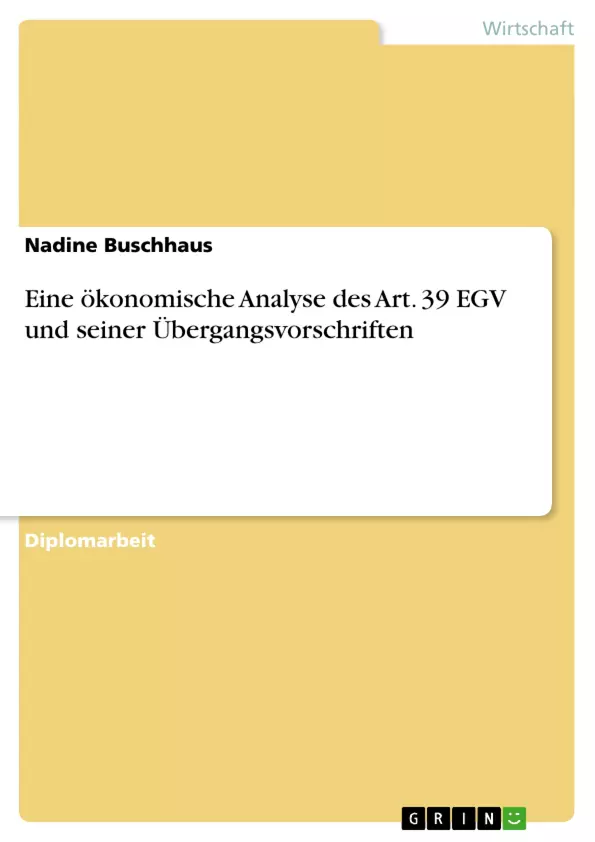The aim of the thesis was to find out whether immigration from the Central and Eastern European countries negatively effects the wage and employment level in the present EU and – if that is the case – whether the implementation of transitional periods for the free movement of workers like in Germany can prevent these negative immigration effects. To better predict the impact of unrestricted and restricted labor migration, the paper analyses several models that take into consideration the skill composition of the
migration workforce, labor market inflexibility in receiving countries, and trade. Considering these variables, the thesis comes to the following conclusions: from an academic perspective, the impact of migration is still controversial. Some theoretical and empirical studies find very small wage and employment effects of migration, others show considerable large impacts. Also for Germany it is unsure if there is really cause for concern. However, recent studies show that migration barriers, like in Germany, are often insufficient to prevent negative wage and employment
effects. Other policy options have to be taken into account.
Inhaltsverzeichnis
- Einleitung und Fragestellung
- Teil I: Das Konzept der Arbeitnehmerfreizügigkeit: Institutionelle Rahmenbedingungen und Migrationspotential
- 1.1. Die europäischen Rahmenbedingungen zur Förderung der Arbeitnehmerfreizügigkeit
- 1.1.1. Der Begriff der Arbeitnehmerfreizügigkeit
- 1.1.2. Die Übergangsregelungen
- 1.2. Mobilität in der Europäischen Union
- 1.2.1. Das Migrationspotential bei vollkommener Arbeitnehmerfreizügigkeit
- 1.2.2. Die potentielle Wanderungslücke
- 1.1. Die europäischen Rahmenbedingungen zur Förderung der Arbeitnehmerfreizügigkeit
- Teil II: Ökonomische Grundlagen der Arbeitnehmerfreizügigkeit
- 2.1. Auswirkungen der Arbeitnehmerfreizügigkeit auf Löhne und Beschäftigung
- 2.1.1. Arbeit als homogener Produktionsfaktor
- 2.1.2. Arbeit als heterogener Produktionsfaktor im Ein-Sektor-Modell
- 2.1.3. Arbeit als heterogener Produktionsfaktor im Zwei-Sektoren-Modell
- 2.2. Empirische Ergebnisse
- 2.1. Auswirkungen der Arbeitnehmerfreizügigkeit auf Löhne und Beschäftigung
- Teil III: Internationale Erfahrungen mit uneingeschränkter Arbeitnehmerfreizügigkeit
- 3.1. Großbritannien
- 3.2. Schweden
- 3.3. Irland
- Teil IV: Der „Fall Deutschland“: Eine Untersuchung der durch die Übergangsfristen eingeschränkten Arbeitnehmerfreizügigkeit
- 4.1. Eine Bestandsaufnahme: Immigration und Arbeitslosigkeit in Deutschland
- 4.2. Theoretische Auswirkungen der Übergangsfristen auf Löhne und Beschäftigung
- 4.2.1. Vorüberlegungen zur Übertragbarkeit der theoretischen Erkenntnisse auf den deutschen Arbeitsmarkt
- 4.2.2. Anwendung der theoretischen Erkenntnisse auf den deutschen Arbeitsmarkt mit Übergangsfristen
- 4.3. Empirische Erkenntnisse
- 4.3.1. Ein Literaturüberblick
- 4.3.2. Mögliche Ansatzpunkte für zukünftige Forschungsarbeiten
- Zusammenfassung
Zielsetzung und Themenschwerpunkte
Die Arbeit beschäftigt sich mit einer ökonomischen Analyse von Artikel 39 des EG-Vertrags und seiner Übergangsvorschriften. Das Ziel ist es, die Auswirkungen der Arbeitnehmerfreizügigkeit auf den Arbeitsmarkt und die Beschäftigung zu untersuchen und die Rolle der Übergangsvorschriften in diesem Zusammenhang zu bewerten.
- Das Konzept der Arbeitnehmerfreizügigkeit und seine institutionellen Rahmenbedingungen
- Die ökonomischen Auswirkungen der Arbeitnehmerfreizügigkeit auf Löhne und Beschäftigung
- Internationale Erfahrungen mit uneingeschränkter Arbeitnehmerfreizügigkeit
- Der Fall Deutschland: Eine Untersuchung der durch die Übergangsfristen eingeschränkten Arbeitnehmerfreizügigkeit
- Empirische Erkenntnisse und Forschungsansätze
Zusammenfassung der Kapitel
- Die Einleitung führt in die Thematik der Arbeitnehmerfreizügigkeit ein und erläutert die Relevanz des Themas im Kontext der Europäischen Union.
- Teil I beleuchtet das Konzept der Arbeitnehmerfreizügigkeit, seine institutionellen Rahmenbedingungen und das damit verbundene Migrationspotential.
- Teil II analysiert die ökonomischen Grundlagen der Arbeitnehmerfreizügigkeit und deren Auswirkungen auf Löhne und Beschäftigung unter verschiedenen Modellannahmen.
- Teil III untersucht internationale Erfahrungen mit uneingeschränkter Arbeitnehmerfreizügigkeit in Großbritannien, Schweden und Irland.
- Teil IV befasst sich mit dem Fall Deutschland und den Auswirkungen der Übergangsfristen auf den deutschen Arbeitsmarkt. Es werden theoretische Erkenntnisse zur Übertragbarkeit auf den deutschen Arbeitsmarkt vorgestellt und empirische Erkenntnisse diskutiert.
Schlüsselwörter
Arbeitnehmerfreizügigkeit, Europäische Union, EG-Vertrag, Übergangsvorschriften, Migrationspotential, Löhne, Beschäftigung, Arbeitsmarkt, Empirische Analyse, Internationale Erfahrungen, Deutschland.
- Arbeit zitieren
- Nadine Buschhaus (Autor:in), 2008, Eine ökonomische Analyse des Art. 39 EGV und seiner Übergangsvorschriften, München, GRIN Verlag, https://www.hausarbeiten.de/document/92230


